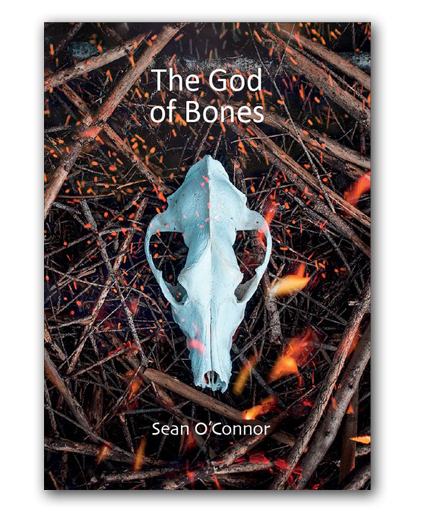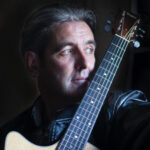
Book Review: The God of Bones
By Sean O’Connor
Published by Alba Publishing
Uxbridge, United Kingdom
2022, Paperback, 74 pages
ISBN: 978-1-912773-53-4
€18, including delivery
Ordering Information
Reviewed by Rich Youmans

In The God of Bones, Sean O’Connor has created an experience both harrowing and hopeful. Throughout the book—his fourth, following his award-winning Fragmentation in 2021—readers traverse war-ravaged landscapes, find communities in ruins, and encounter episodes of brutality and abandonment, in which the fragility of human existence is laid bare. And yet, by the end, the tone is not of grief and anger, but of acceptance and even transcendence. The haibun emphasize a Zen-like shedding of self and attachment—an approach that leads if not to redemption, then to rebirth.
O’Connor achieves this through an interweaving of haibun, stand-alone haiku (plus one tanka), and quotations that range from excerpts of classic Japanese literature to a Zen koan. Divided into five sections, the book takes as its leitmotif the titular god: each section begins with a different “God of Bones” haibun in which directives are given on what to do with parts of a skeleton. Taken together, the five haibun could be read as a sequence, moving from the gathering and grinding of the bones to the dissembling and rejoining of them into a dancer, producing something of a Danse Macabre that ultimately leads to new life.
Each “God of Bones” haibun introduces, to some degree, the overall themes of its section. Here, for instance, is “The God of Bones I”:
The most delicate and plentiful are the bones of a child: gather them up with care and place on starched linen over an altar of stone.
We sing to them for hope, and on nights when storms rage, in candle glow, we vigil them with murmuring prayers.
the chirps of siskins
among blackened mourners
two white coffins
What follows is a devastating haiku (“first light—/our stillborn boy/in all his perfection”) followed by two connected haibun, “Secrets” and “Daily Bread,” that relate the story of an Irish girl, Millie Dwyer, who dies while giving birth in “the grotto behind the closed church … the first night she ever spent outside the house she was born in.” That implication that the child’s father was inside her own house, and that Millie was a victim of sexual abuse, is picked up elsewhere in this section (most pointedly in the ironically titled haibun “Something Good,” which contains the haiku “in the darkest night/the rasp of father’s stubble/reddening soft thighs”). An undercurrent of religion also pervades the chapter, with the implication that it has let down its followers. That implication is made vivid in the section’s final haibun, where an adult son dies when the altar of an old church collapses. The capping haiku (“funeral cortège/stopping for a cat to pass/kitten in its mouth”) echoes the haiku that opens “Secrets” (“mother cat/discarding the silent kitten/from her noisy litter”), closing the circle of apparent betrayal by both family and faith.
The next two sections expand the scope of the devastation. The second “God of Bones” haibun refers to those “who waste their lives in the ardent pursuit of power and riches,” and it issues a call to “[g]rind every bone to a powder so fine, even the slightest breeze will vanish them.” The haibun in this section emphasize this call, focusing on communities where suspicion, murder, and destruction reign. We come upon a village burned to the ground by soldiers, a temple destroyed by a suicide bomber (capped by the brutal haiku, “Easter Sunday/a line of children’s flip-flops/drenched in blood”), and a town that publicly hangs “collaborators” who once were their neighbors. O’Connor conveys the gruesomeness and sense of pending doom vividly, in clear, matter-of-fact language that only accentuates the horror. “The Dentist” offers a good example:
this year’s first
a blue butterfly
on a taut ropeEveryone liked the dentist, he was pleasant, and no one thought about his ethnicity; he’d grown up in the town.
But civil wars unfold insidiously, one incident after another, until there comes an undeclared point when war has clearly broken out.
For us, for our town, that was the day the dentist was dragged from his clinic by people who knew him well, his neighbours, his patients. They broke his spine and hung him from a lamp post by his wrists.
The dentist, our dentist, hung there at the corner of his street, in view of his dental practice, and close to the school whose children passed him twice a day in their uniforms.
It was four days before he died. His body left hanging there, until one morning, it was gone.
The haiku’s imaginative way of describing the jerky movements of the butterfly portend the dentist’s ultimate demise, and that image haunts the last line of the prose. For me, though, it’s the opening of the fourth paragraph—”The dentist, our dentist”—that hits home most. Despite claiming him as one of their own, the crowd still allows the dentist to die slowly and in plain view of all, and in so doing kills the idea of community that held them together.
The third section moves into war-torn regions. Two haibun are set in Bosnia and Herzegovina, another focuses on a soldier’s ordeal in Iraq. In others, the settings aren’t identified, but the same atmosphere pervades—of fear and suffering, filled with the cracking of sniper bullets and the wailing of sirens as missiles approach. The narrators in these pieces find what little protection and comfort they can:
By the banks of the Miljacka, we converge, seeking safety in the shade of a concrete wall; too small for comfort, but high enough for hope. Together we crouch and cower.
. . .
midday heat . . .
with death in all directions
soft the sound of water(from “Soft”)
“Death in all directions” pretty much sums up the haibun so far, and readers could be forgiven if they’re now viewing the world and human existence with something approaching despair. But the quotations offer a different, more philosophical perspective. Appearing between each section, they serve somewhat as markers of the book’s underlying arc. The first, from Heike Monogatari, refers to the “impermanence of all things” and how “the mighty fall at last, they are as dust before the wind.” The second, the Zen koan “Everything is okay,” could be read facetiously or, more likely, as a reminder that existence has an undercurrent that’s deeper than ephemeral human affairs. The third epigraph, from Jun’ichirou Tanizaki’s In Praise of Shadows, expands upon that thought, emphasizing the rightness of simply being: “If light is scarce then light is scarce; we will immerse ourselves in the darkness and there discover its own particular beauty.” Together, these quotes urge readers to rise above the carnage, broaden our perspectives beyond ourselves, and shed the limitations of our egos.
All of this begins to coalesce in the fourth section. The quotation preceding this section quotes the opening of Matsuo Basho’s Oku no Hosomichi: “The months and days are the travellers of eternity … Those who float away their lives on ships or who grow old leading horses are forever journeying, and their homes are wherever their travels take them.” The narrator becomes a traveler, a pilgrim. A sense of detachment begins to take over, as articulated in this haiku from “The God of Bones IV”:
this nothingness world in all its insouciance slow-falling snow
In this section, the haibun turn more personal, with accounts of the author’s travels and the friends he’s lost along the way. A sense of things disappearing, including one’s self, reverberates through the narratives.
Stop to eat. Hunger without appetite. This pointless longing. Somehow amplified by the fact of breathing. Alive in hostility. Downhill. Steps heavy and awkward. The air becomes salty. The ground leveling out. Finally:
lying prostrate inching over the cliff now I hear it!in this world no-one knows where I am nobody(from “Lost”)
This section also introduces new gods. The God of Water (perhaps a reference back to the earlier “soft sound of water” that played underneath the wails and cries of destruction) offers urgings and consolations to help the traveler along. Later we meet the Wind God, who calls the narrator “by my forever name, the one I had before mother and father were born.” In the section’s final haibun, the aptly titled “Clarity,” the wind seems to sweep out the narrator’s remaining sense of self and leads him to contemplate his own death, “leaving only the pile of my bones to be nudged for years by travelling storms, rivulets from sudden rainfalls, or strolling clumsy beasts.”
Should my skull rest sideways, what creature will see my foramen magnum as their doorway, and rest and birth, and feed and rear and nurture in the space that was my brain? And what young will see the world through the sockets of my eyes where I saw everything and nothing?
The call of a single bird, with all its threats and promises, simplifies the silence I seek, the solidity, and I take a step. One step. Into a falling world.
light on limestone
through the depth of a cave
a dustless beam
The traveler has seemingly reached the ultimate destination, losing his self and leaving behind the horrors of the world. And yet the questing spirit, “a dustless beam,” continues. What’s next?
The last section of the book provides an answer and serves almost as a coda, offering only three haibun and a haiku. It’s preceded by a quotation from the Spanish poet Antonio Machado, continuing the theme of pilgrimage: “Wayfarer, only your footprints are the path, and nothing more; wayfarer, there is no path, you make the path as you walk.” From there we’re introduced to Death as Dancer, the God of Bones reassembled into a tanguera in a “glorious red dress.” In the penultimate haibun, “Tango,” Death reminds the narrator of her dual nature—”I may be death,” she says, “but I give life too”—just before the dance begins:
We hold each other, Death and I, our breath one, in tender equilibrium.
No-one can hear our music.
Then that moment, the moment we move.
whispering breeze—
the daffodil heads
turned to the sun
That call to the light ends with “Perfection,” in which four babies, just a few days old, are being nurtured and protected from shards of glass should the surrounding windows blow in. We are again in a war-torn region, but unlike in the earlier haiku where the perfect baby was stillborn, here we find
Spring sunlight—
so perfectly formed
eight tiny hands
This intricate framework is what ultimately makes A God of Bones so powerful, and it’s easy to see why the book was recently honored in both the Touchstone and the Haiku Society of America book award competitions. At his best, O’Connor has a light touch to his prose that draws in the reader. The haiku all take the traditional three-line format, but their approach varies. Some resonate subtly with the prose while also working as poems in their own right (“whispering breeze,” above, is a particular favorite of mine). Others seem to serve more as highlighted images or moments that, while they may not be able to stand on their own, augment the prose potently. Regardless of approach, they all work well and actually become stronger in the context of this book. The running themes, images, and metaphors create a robust connective tissue around the volume’s basic structure (its “bones,” if you will), allowing the individual haibun to resonate with one another and take on deeper meanings. Just like the elements of a good haibun, the parts of this book add up to a greater whole. And when read as a whole, from beginning to end, The God of Bones takes us on a journey we won’t soon forget.
About the Reviewer

Rich Youmans lives on Cape Cod with his wife, Alice. His books include All the Windows Lit (Snapshot Press, 2017) and Head-On (Red Bird Chapbooks, 2018). He is also the co-author, with Roberta Beary and Lew Watts, of Haibun: A Writer’s Guide (Ad Hoc Fiction, 2023).

A marvelous book!